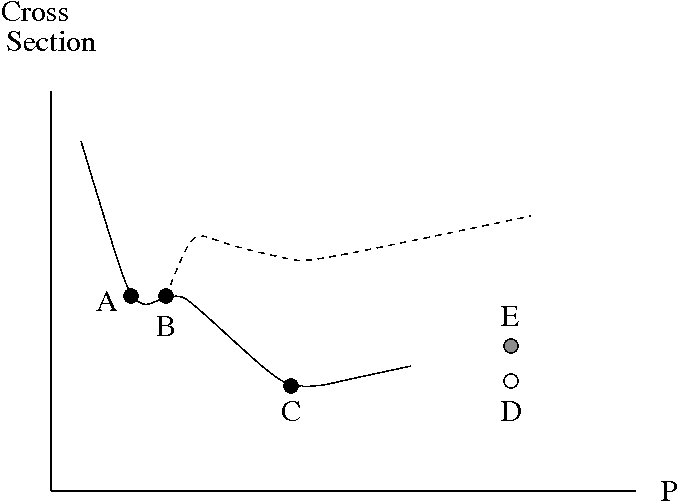|
|
 Figure 1: The pre-LHC proton-proton cross section versus the
laboratory momentum P. Axes are drawn in a logarithmic scale.
The continuous line denotes
elastic cross section and the broken line denotes total cross section.
Points A-E help the discussion (see text).
(The accurate figure can be found in [1]).
Figure 1: The pre-LHC proton-proton cross section versus the
laboratory momentum P. Axes are drawn in a logarithmic scale.
The continuous line denotes
elastic cross section and the broken line denotes total cross section.
Points A-E help the discussion (see text).
(The accurate figure can be found in [1]).
Remark:
The elastic and total cross section depicted in fig. 1 were
published in the annual PDG report for quite a few years. It
is explained later in this text why these plots certainly
disprove QCD. It turns out that for an unclear reason, since
2013 this figure is not included in the PDG annual report any
more. In particular, the overall elastic p-p plot has been
removed altogether. Since people mainly use the most recent
report, they cannot see that for high energy the relative
portion of the elastic p-p cross section stops decreasing and
that its absolute value begins to increase.
Let us examine the relevance of the
data of the proton-proton elastic cross section (ECS)
depicted in fig. 1 to some very well established physical principles.
The discussion is carried
out in the rest frame of one proton (the target). The
second proton (the projectile)
interacts with the potential of the target. As the linear
momentum of the projectile increases, its wave length decreases
and its wave function changes sign more rapidly. Therefore, spatial
regions where the potential varies slowly make a very
small contribution to the cross section of a very high energy collision.
This general quantum
mechanical argument proves that in the case of a very short wave length
of the projectile, a meaningful contribution to the scattering process
is obtained only from regions
where the potential varies strongly.
The 1/r variation of the Coulomb potential provides
a quantitative information
on the slope of the cross section's graph as a function of the projectile's
momentum. As is well known, the Coulomb potential leads
to the Rutherford and the Mott scattering
formulas, where the ECS falls like 1/p2.
The data on the left hand side of point A is consistent
with these formulas.
The ECS rise between points A-B is explained by the
nuclear force which is much stronger than the electric Coulomb
force. This force is characterized by a strong repulsive force
at a short distance and an attractive force outside it.
Now, if the radial distance increases then the nuclear
attractive force falls much more rapidly than the Coulomb
force. Therefore, at regions where it is not negligible,
the radial variation of the nuclear force
is much stronger than that of the Coulomb force.
These arguments explain the twist of the graph at points
A-B. It can be concluded that
the data on the left hand side of point B,
together with our knowledge of the Coulomb and the nuclear forces,
support the quantum mechanical approach described above.
Let us examine the data for a momentum which is higher than
that of point B. Here, like in the case of electron-proton
deep inelastic scattering, the protons may be reagrded not as one
particle but as a
set of quarks (and of other objects). However, the quantum
mechanical laws described above, are assumed to be valid.
The momentom of point B is about 1 GeV/c. The data
described in fig. 1 is given for a laboratory momentum up to
about 2000 GeV/c and for a much higher momentum found in
cosmic rays. Now, even at the smaller momentum range of
the more reliable laboratory data, one finds
that the cross section describes a physical state which is
very, very far from the Coulomb related formulas of
Rutherford and Mott. In particular,
for a linear momentum larger than that of point C,
ECS stops decreasing and begins to increase.
Now, it is argued that QCD is characterized by a decrease
of the coupling constant at a short distance from quarks.
This QCD property is called asymptotic freedom (see, e.g.
[2]). This fact means that at very short distance,
the radial variation of the QCD force is smaller than that
of the Coulomb force. Thus, on the basis of the foregoing discussion,
one infers that the QCD quark-quark elastic cross section graph is expected to
show a steeper decrease than that of the Coulomb interaction, which is
seen on the left hand side of point A. This expectation
is certainly inconsistent with the data of fig. 1.
Therefore, it is not clear how can one reconcile
QCD with the data of fig. 1.
The inconsistency of QCD with the experimental data of fig. 1
has already been pointed out in the literature
Click here.
For reading a text explaining why the data of fig. 1
is inconsistent with QCD
Click here.
For reading a paper explaining the data of fig. 1,
Click here.
For reading its sequel paper
Click here.
For reading a no_higgs discussion and other aspects of the upcoming LHC data
Click here.
References:
[1] C. Amsler et al., Phys. Lett. B667, 1 (2008).
(See p. 364) or see p. 12
here.
[2] M. E. Peskin and D. V. Schroeder, An Introduction to
Quantum Field Theory (Reading Mass., Addison, 1995).
(See pp. 479, 480).
|
|
|
|

